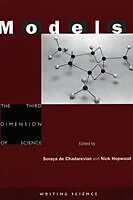Models
Einband:
Kartonierter Einband
EAN:
9780804739726
Untertitel:
The Third Dimension of Science
Genre:
Naturwissenschaften allgemein
Herausgeber:
Stanford University Press
Anzahl Seiten:
488
Erscheinungsdatum:
15.07.2004
ISBN:
978-0-8047-3972-6
Zusatztext "I highly recommend this volume to every historian and philosopher of science. It will most certainly stimulate research in this important area of scientific practice and thus have a legacy that goes beyond the rich collection of materials assembled. Dare I say that it might even become a model for future explorations of the material culture of science?" Informationen zum Autor Soraya de Chadarevian is Senior Research Associate in the Department of History and Philosophy of Science, University of Cambridge. She is the author, most recently, of Designs for Life: Molecular Biology after World War II (2002). Nick Hopwood is Lecturer in the Department of History and Philosophy of Science, University of Cambridge. His publications include Embryos in Wax: Models from the Ziegler Studio (2002). Klappentext This book is about wooden ships and plastic molecules, wax bodies and a perspex economy, monuments in cork and mathematics in plaster, casts of diseases, habitat dioramas and extinct monsters rebuilt in bricks and mortar. Considering such objects together for the first time, this interdisciplinary volume demonstrates how, in research as well as teaching, 3-D models played major roles in making knowledge. Zusammenfassung Now that '3-D models' are so often digital displays on flat screens! it is timely to look back at the solid models that were once the third dimension of science. This book is about wooden ships and plastic molecules! wax bodies and a perspex economy! monuments in cork and mathematics in plaster! casts of diseases! habitat dioramas! and extinct monsters rebuilt in bricks and mortar. These remarkable artefacts were fixtures of laboratories and lecture halls! studios and workshops! dockyards and museums. Considering such objects together for the first time! this interdisciplinary volume demonstrates how! in research as well as in teaching! 3-D models played major roles in making knowledge. Accessible and original chapters by leading scholars highlight the special properties of models! explore the interplay between representation in two dimensions and three! and investigate the shift to modelling with computers. The book is fascinating reading for anyone interested in the sciences! medicine! and technology! and in collections and museums. ...
Autorentext
Soraya de Chadarevian is Senior Research Associate in the Department of History and Philosophy of Science, University of Cambridge. She is the author, most recently, of Designs for Life: Molecular Biology after World War II (2002). Nick Hopwood is Lecturer in the Department of History and Philosophy of Science, University of Cambridge. His publications include Embryos in Wax: Models from the Ziegler Studio (2002).
Klappentext
"This finely focused theme and the historical specificity of each author's contribution sustain and propel the reader through this rich, provocative collection,"--Science Magazine
" . . . [T]he wide-ranging chapters suggest intriguing aproaches to the investigation of objects which readers may wish to emulate."--Rittenhouse: Journal of the Scientific Instrument Enterprise
Zusammenfassung
Now that '3-D models' are so often digital displays on flat screens, it is timely to look back at the solid models that were once the third dimension of science. This book is about wooden ships and plastic molecules, wax bodies and a perspex economy, monuments in cork and mathematics in plaster, casts of diseases, habitat dioramas, and extinct monsters rebuilt in bricks and mortar. These remarkable artefacts were fixtures of laboratories and lecture halls, studios and workshops, dockyards and museums. Considering such objects together for the first time, this interdisciplinary volume demonstrates how, in research as well as in teaching, 3-D models played major roles in making knowledge. Accessible and original chapters by leading scholars highlight the special properties of models, explore the interplay between representation in two dimensions and three, and investigate the shift to modelling with computers. The book is fascinating reading for anyone interested in the sciences, medicine, and technology, and in collections and museums.

Leider konnten wir für diesen Artikel keine Preise ermitteln ...
billigbuch.ch sucht jetzt für Sie die besten Angebote ...
Die aktuellen Verkaufspreise von 6 Onlineshops werden in Realtime abgefragt.
Sie können das gewünschte Produkt anschliessend direkt beim Anbieter Ihrer Wahl bestellen.
Loading...
Die aktuellen Verkaufspreise von 6 Onlineshops werden in Realtime abgefragt.
Sie können das gewünschte Produkt anschliessend direkt beim Anbieter Ihrer Wahl bestellen.
| # | Onlineshop | Preis CHF | Versand CHF | Total CHF | ||
|---|---|---|---|---|---|---|
| 1 | Seller | 0.00 | 0.00 | 0.00 |
